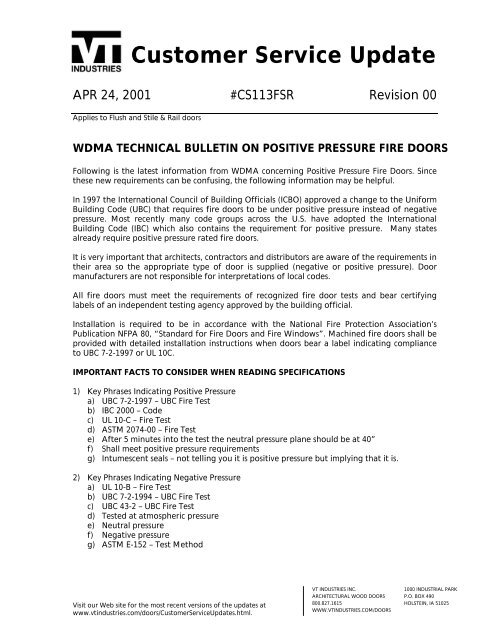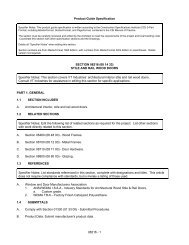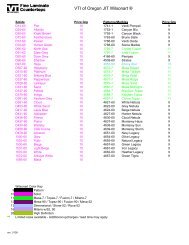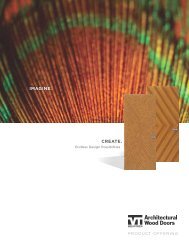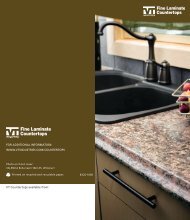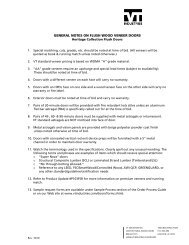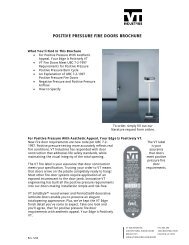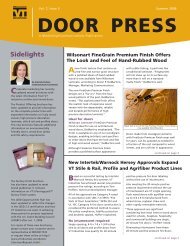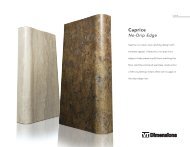wdma technical bulletin on positive pressure fire ... - VT Industries Inc
wdma technical bulletin on positive pressure fire ... - VT Industries Inc
wdma technical bulletin on positive pressure fire ... - VT Industries Inc
Create successful ePaper yourself
Turn your PDF publications into a flip-book with our unique Google optimized e-Paper software.
Customer Service Update<br />
APR 24, 2001 #CS113FSR Revisi<strong>on</strong> 00<br />
Applies to Flush and Stile & Rail doors<br />
WDMA TECHNICAL BULLETIN ON POSITIVE PRESSURE FIRE DOORS<br />
Following is the latest informati<strong>on</strong> from WDMA c<strong>on</strong>cerning Positive Pressure Fire Doors. Since<br />
these new requirements can be c<strong>on</strong>fusing, the following informati<strong>on</strong> may be helpful.<br />
In 1997 the Internati<strong>on</strong>al Council of Building Officials (ICBO) approved a change to the Uniform<br />
Building Code (UBC) that requires <strong>fire</strong> doors to be under <strong>positive</strong> <strong>pressure</strong> instead of negative<br />
<strong>pressure</strong>. Most recently many code groups across the U.S. have adopted the Internati<strong>on</strong>al<br />
Building Code (IBC) which also c<strong>on</strong>tains the requirement for <strong>positive</strong> <strong>pressure</strong>. Many states<br />
already require <strong>positive</strong> <strong>pressure</strong> rated <strong>fire</strong> doors.<br />
It is very important that architects, c<strong>on</strong>tractors and distributors are aware of the requirements in<br />
their area so the appropriate type of door is supplied (negative or <strong>positive</strong> <strong>pressure</strong>). Door<br />
manufacturers are not resp<strong>on</strong>sible for interpretati<strong>on</strong>s of local codes.<br />
All <strong>fire</strong> doors must meet the requirements of recognized <strong>fire</strong> door tests and bear certifying<br />
labels of an independent testing agency approved by the building official.<br />
Installati<strong>on</strong> is required to be in accordance with the Nati<strong>on</strong>al Fire Protecti<strong>on</strong> Associati<strong>on</strong>’s<br />
Publicati<strong>on</strong> NFPA 80, “Standard for Fire Doors and Fire Windows”. Machined <strong>fire</strong> doors shall be<br />
provided with detailed installati<strong>on</strong> instructi<strong>on</strong>s when doors bear a label indicating compliance<br />
to UBC 7-2-1997 or UL 10C.<br />
IMPORTANT FACTS TO CONSIDER WHEN READING SPECIFICATIONS<br />
1) Key Phrases Indicating Positive Pressure<br />
a) UBC 7-2-1997 – UBC Fire Test<br />
b) IBC 2000 – Code<br />
c) UL 10-C – Fire Test<br />
d) ASTM 2074-00 – Fire Test<br />
e) After 5 minutes into the test the neutral <strong>pressure</strong> plane should be at 40”<br />
f) Shall meet <strong>positive</strong> <strong>pressure</strong> requirements<br />
g) Intumescent seals – not telling you it is <strong>positive</strong> <strong>pressure</strong> but implying that it is.<br />
2) Key Phrases Indicating Negative Pressure<br />
a) UL 10-B – Fire Test<br />
b) UBC 7-2-1994 – UBC Fire Test<br />
c) UBC 43-2 – UBC Fire Test<br />
d) Tested at atmospheric <strong>pressure</strong><br />
e) Neutral <strong>pressure</strong><br />
f) Negative <strong>pressure</strong><br />
g) ASTM E-152 – Test Method<br />
Visit our Web site for the most recent versi<strong>on</strong>s of the updates at<br />
www.vtindustries.com/doors/CustomerServiceUpdates.html.<br />
<strong>VT</strong> INDUSTRIES INC.<br />
ARCHITECTURAL WOOD DOORS<br />
800.827.1615<br />
WWW.<strong>VT</strong>INDUSTRIES.COM/DOORS<br />
1000 INDUSTRIAL PARK<br />
P.O. BOX 490<br />
HOLSTEIN, IA 51025
Customer Service Update<br />
3) Phrases That D<strong>on</strong>’t Tell You If It Is Positive Or Negative<br />
a) NFPA 101 – Life Safety Code<br />
b) NFPA 105 – Smoke and Draft C<strong>on</strong>trol Document<br />
c) NFPA 252 – Fire Test method which gives the opti<strong>on</strong> to be <strong>positive</strong> or negative<br />
d) UBC – With no date given could be either <strong>positive</strong> or negative<br />
e) UL 1784 – Air Leakage Test for Door Assemblies<br />
f) NFPA 80 – Installati<strong>on</strong> standard for <strong>fire</strong> doors and windows<br />
POSITIVE PRESSURE DOOR INFORMATION<br />
1) Methods Of Compliance<br />
Positive <strong>pressure</strong> openings can be accomplished in two basic ways:<br />
The first is described as Category “A” doors:<br />
Doors – No Additi<strong>on</strong>al Edge-Sealing System Required<br />
This category includes doors evaluated without any intumescent <strong>on</strong><br />
either the frame or door. It also includes doors evaluated with<br />
intumescent incorporated into the edge of the door by the manufacture<br />
or licensed machiner.<br />
The sec<strong>on</strong>d method is called Category “B” doors:<br />
Doors – Additi<strong>on</strong>al Edge-Sealing System Required<br />
This category includes doors evaluated with an intumescent applied to<br />
the frame – either surface applied or “built-in”.<br />
2) S Label Smoke Rating<br />
Many <strong>positive</strong> <strong>pressure</strong> openings will also require a smoke seal. An “S” label requirement<br />
indicates the opening needs to have Smoke and Draft C<strong>on</strong>trol Gasketing. This category “H”<br />
includes gasket systems that are surface-applied (such as kerf applied, adhesive backed or<br />
mechanically attached) to frames or doors. It includes gasketing for the meeting edges for<br />
use in pair and double egress assemblies. This category covers gasket systems that have been<br />
evaluated for use in <strong>positive</strong> <strong>pressure</strong> rated assemblies but do not provide an edge-sealing<br />
system to the opening as described below.<br />
3) Edge-Sealing Systems<br />
This category “G” includes intumescent-type systems that are surface applied (such as kerf<br />
applied, adhesive backed or mechanically attached) to frames or doors. It includes seals for<br />
meeting edges for use in pair and double egress assemblies.<br />
4) Door Specificati<strong>on</strong> Descriptors<br />
Secti<strong>on</strong> G-1, of the WDMA I.S. 1-A lists the different types of flush door c<strong>on</strong>structi<strong>on</strong>s<br />
available in the industry. Fire rated flush doors for <strong>positive</strong> <strong>pressure</strong> openings are<br />
designated with the “PP” suffix. Stile and Rail doors as described by WDMA I.S. 6A are also<br />
available for <strong>positive</strong> <strong>pressure</strong> openings based <strong>on</strong> specific manufacturer’s approvals.<br />
The change to <strong>positive</strong> <strong>pressure</strong> requirements can be c<strong>on</strong>fusing as the new codes are<br />
implemented and various door, frame and hardware manufacturers develop new products to<br />
meet those requirements. For additi<strong>on</strong>al informati<strong>on</strong> c<strong>on</strong>tact your Architectural Wood Door<br />
Manufacturer or WDMA.<br />
Visit our Web site for the most recent versi<strong>on</strong>s of the updates at<br />
www.vtindustries.com/doors/CustomerServiceUpdates.html.<br />
<strong>VT</strong> INDUSTRIES INC.<br />
ARCHITECTURAL WOOD DOORS<br />
800.827.1615<br />
WWW.<strong>VT</strong>INDUSTRIES.COM/DOORS<br />
1000 INDUSTRIAL PARK<br />
P.O. BOX 490<br />
HOLSTEIN, IA 51025


